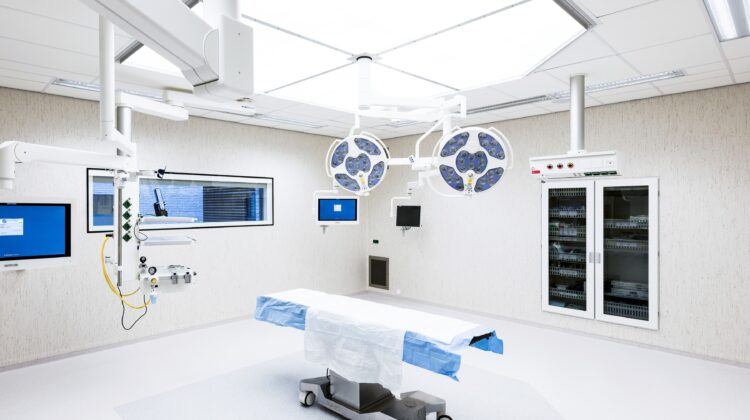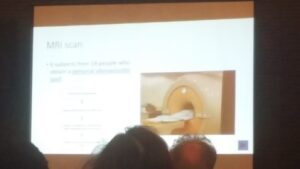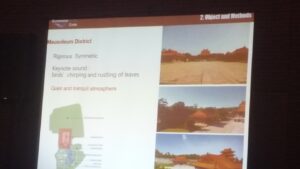
Our editor Andrea Harman, Concept Developer for Healthcare in the UK, attended Euronoise in Crete. Here are her main takeaway points from the session: Building Acoustics and Health.
Effects of children charcteristics on sound environment in fast food restaurants in china – Liu Shanshan
This interesting session started with the question would you like to eat with a little angel or little devil? The speaker felt that the introduction of soft play areas into fast food restaurants encouraged the noisy “devil” to appear in a child. Measuring the sound pressure levels of 3-6 year olds playing she correlated the information to the number of children playing and the pattern of interaction in the play. Finding that an increase in the number of children did not necessarily lead to an increase in the level of sound. As a small group of children are more likely to play interactively and generate more noise. Whereas a larger group tend to play more independently and so more quietly
Evaluation and improvement of the acoustic comfort in nursing homes: a case study in Flanders Belgium – Pieter Thomas et al
The aim of this project was to improve everyday life for care home residents and the conditions for staff. Pieter and the team monitored 5 new or recently renovated nursing homes lived in by older citizens and people with dementia as a part of this study. All were monitored for a typical week of operation. They found that noise levels increased and decreased at various times of day in line with activities. So for example breakfast time was a noisier time with levels up to 60dBa. The main challenge apperared to be the transfer of noise from the corridor to bedrooms and bedrooms to corridor. And sound propagation along the corridor; with doors being a particular weak spot allowing transfer of sound. The solution to the challenge of the doors in one home with one particularly noisy resident whose screaming was upsetting other residents was to add an acoustic curtain inside the room to help absorb the sound. As a side note I would comment that although this worked well with this particular resident who was unable to move independently it could however could be confusing for more mobile residents if they cannot find the door to a room because it is blocked by a curtain. The corridor solution was the introduction of sound absorbing panels to the ceilings in corridors. This significantly reduced the reverberation time.
The nurses found the acoustically treated spaces a more pleasant environment to work in, but are in themselves part of the problem. So the study felt a further solution would be to make them more aware of their impact on the sound environment and how they can influence it.
Human sleep in silent environment: experiment and results – Chen Yuxiao
This experiment looked at what happens to sleep when you take noise away. Does a very quiet environment (less than 5dB background noise) lead to a good night’s sleep or does the silent environment inhibit sleep? Could it be too quiet?
The bedrooms used were very nice looking and comfortable with good air flow of unpolluted air. People were monitored for the whole night both in the this room and in their own bedroom. It was found that they averaged longer and deeper sleep in the quiet environment with increased levels of REM sleep. Although interestingly some people sleep worsened in the quiet room the gains made by those whose sleep was improved far outweighed this and improved the average.
Experimental research for skull vibration from vocalisation impact on cerebrospinal fluid circulation – Li hui
 The starting point for this study was that deaf children have a low IQ. Whilst blind children share an IQ level similar to hearing and sighted children so how does speech influence our brain. The theory is that skull vibration from vocalisation promotes the diffusion process helps clear plaques on brain tissue and CSF flow increases with vibration. Specifically the sound “eeeee” works best. The link to a decreasing risk of stroke from increased vocalisation was also discussed. Whilst it was generally felt that more needs to be known about the impact of the sounds deaf children do vocalise. And why they do or do not have an effect and whether external vibration such as from playing a violin would have an effect, the audience enjoyed the participation and making the relevant sounds.
The starting point for this study was that deaf children have a low IQ. Whilst blind children share an IQ level similar to hearing and sighted children so how does speech influence our brain. The theory is that skull vibration from vocalisation promotes the diffusion process helps clear plaques on brain tissue and CSF flow increases with vibration. Specifically the sound “eeeee” works best. The link to a decreasing risk of stroke from increased vocalisation was also discussed. Whilst it was generally felt that more needs to be known about the impact of the sounds deaf children do vocalise. And why they do or do not have an effect and whether external vibration such as from playing a violin would have an effect, the audience enjoyed the participation and making the relevant sounds.
An investigation into the soundscape harmony between historic mausoleum and modern urban park – Zhang Yuan
 A large tomb from the Quing dynasty in China is open to the public it is set in a large space of land that is now a public park that contains many activities and a more peaceful woodland setting. It was felt that the noise form the active park would interrupt with the atmosphere of respect found around the mausoleum and felt by visitors to the tomb. It was found that whilst people feel more comfortable in the wooden area a better transition is needed between the active and quiet spaces.
A large tomb from the Quing dynasty in China is open to the public it is set in a large space of land that is now a public park that contains many activities and a more peaceful woodland setting. It was felt that the noise form the active park would interrupt with the atmosphere of respect found around the mausoleum and felt by visitors to the tomb. It was found that whilst people feel more comfortable in the wooden area a better transition is needed between the active and quiet spaces.
Effects of indoor and outdoor noise on residents annoyance and blood pressure – Park Sang Hee
300 residents aged between 20 and 60 took part in this study. All had normal blood pressure and did not take blood pressure medication. The study assessed how annoyed they were by both indoor and outdoor noise and whether this annoyance affected their blood pressure.
It was found that those who rated noise annoyance higher did so for both indoor and outside noise so they may have been more sound sensitive. The more annoyance people felt by noise the higher their blood pressure was. It did not matter if this was indoor or outdoor noise
Acoustics in operating theatres with modular building technique – Maria Quinn
Maria’s presentation started by showing the high sound levels in hospital including the sound level in operating theatres which are extremely noisy spaces. She showed that whilst the Swedish standard SS25268 sets a maximum reverberation time of 0.6 seconds the developers of the increasingly popular modular operating theatres did not appear to know or account for this. In her study the aim was to affect a modular building by adding a 40mm thick sound absorber to the ceiling to meet the 0.6 second requirement. The sound absorbent ceilings had to meet infection control requirements and because of the structure of the space absorption could not be added to the walls. Based on two different designs and size of theatre space (65m2 and 105m2) , T20 and C50 were measured to give a reverberation time and speech clarity, so a perceivement of how sound was actually felt in the space.

It was found to be really difficult to achieve 0.6 seconds reverberation time in the larger space and speech frequencies were a specific problem. So the decision was made to add an additional 50mm bass frequency absorber to the back of the ceiling. This had a significant reducing the reverberation time form 0.9 seconds to the 0.6 seconds required by the standard and showed an improvement in speech clarity. Read more about the project here.
For more information about the session and Building Acoustics and Health, please contact Andrea Harman.

